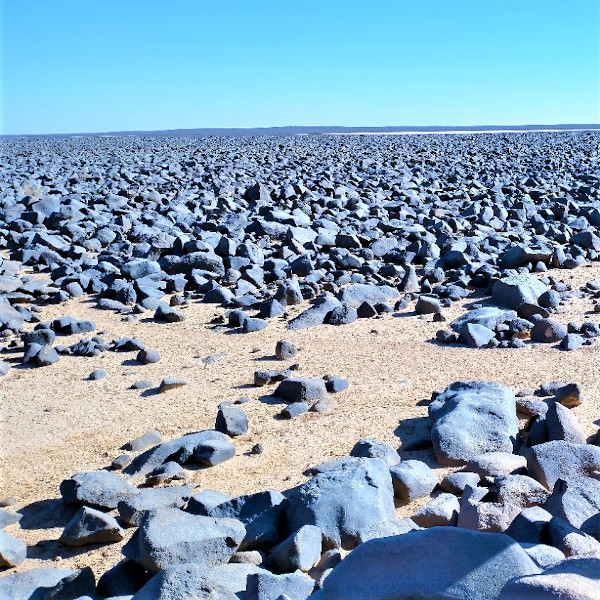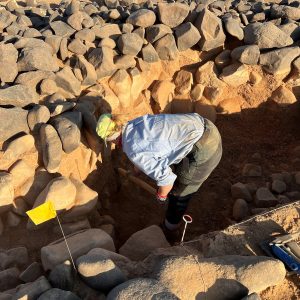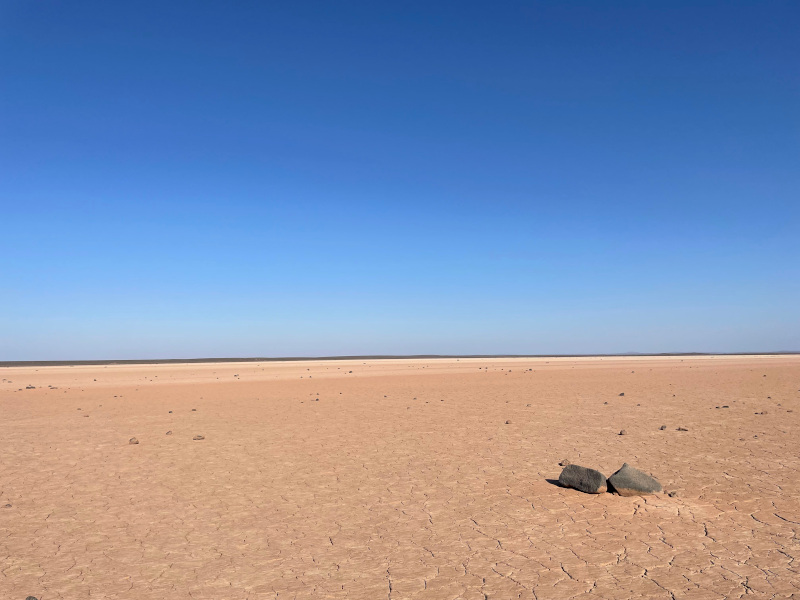
The Colors of the Badia
From the sky, the kites of the Jordanian Steppe are easy to spot. The low walls of piled basalt stone stand out against the tan landscape in vivid, dark lines that continue off into the distance. The theory goes that these are the remains of ancient animal traps, guiding prey along the straight lines of the two arms and into the danger of an enclosed area.
As we walked up to site each morning, I couldn’t help feeling a little bit like one of these ancient ruminants. Like unlucky gazelles, the members of the ‘Kites in Context’ project followed these arms across the basalt fields toward the excavation site. When I had been shown the landscape from above, I had assumed that this route would make for an easy journey – we were following a wall, after all. Yet to my surprise, the unmistakable lines of black on beige that I had seen in the aerial photographs were, on the ground, far less distinct. From ground level, the wall was an uneven gray line in a gray sea of stone. Looking up at the hill, it was only barely possible to pick up the darker shades of a low wall running along it – and even then, only once I was pointed in the right direction – but the closer we got, the more it seemed to vanish into the landscape around it. How on earth was I supposed to follow this every day?


Truth be told, I never did get the hang of following walls, but in the end, I did not need to. As we walked the same paths every day, our shoes disturbed the fawn-colored dirt and tracked it across the pewter-colored stones, leaving a little ribbon of sepia across the landscape. Before long, these ephemeral lines of powdery dust criss-crossed the camp, the hills, and the kite enclosure where we were working. Paths between excavation sections, paths over walls to the sieve, paths off into the desert to the bathroom, straight, efficient paths to the tea tent for our afternoon break. Everywhere we went, we trailed dust behind us and this is how I came to know my way around, following the slippery footpaths like an ant follows a scent trail. Had it rained, I would have been totally lost.

Down in the section getting dustier and dustier. Photo credit Quinn Comprosky.
Indeed, it seemed like everything we touched was turning that same dusty-brown hue. When we arrived, everything was colorful. The truck pulled up full of reds and blues and yellows and greens. But in the onslaught of sun and sand and sweat, everything took on a decidedly desert patina. Our clothes were beige, our tents were beige, our notebooks, gear, and pens were beige. No matter how often we washed, our hair and skin were beige. When we sneezed, it was beige. In photos, we all look like the survivors of an explosion in a powder foundation factory.
But the more monochrome we became, the more I started to notice new shades in the world around me. My early sketches of the desert are all the same: blue streak, gray streak, tan streak. Above is a wide, expansive blue sky, below is the dusty tan of the local soil, and dividing the two is a line of basalt gray. It’s the same in the high-quality photographs taken by Chad: the world is black and tan and blue as far as the eye can see. But as my eyes adjusted to this new tritone palette, I began to see new colors in the landscape – shades that I had never imagined could be there. Against the warm tones of the everpresent dirt, the harsh tones of the basalt took on cooler notes. As we stamped across ancient lava fields, shimmering and shifting in the heat, the oppressive grays began to bloom into a spectrum of muddy blues and dusty purples. In the section, the buried stones seemed to emerge like dusty shards of hazy blue sky. Hot and filthy and tired, I saw the desert differently than when I had arrived, cool and clean and full of energy.

For all the horrible heat and the terrible dirt and the wind that blows away anything not nailed down, I like being out in the desert. I like the way that this harsh place makes me see things differently – to see color where I had once seen sepia and trails where I had once seen empty plains of stone. It lets me see with the objective eye of a tape measure and a camera lens, but also with the fallible human eye of someone too hot, too tired, and too frustrated to spot the wall they’re standing on. Of course, it also helps me see the benefit of cold water and air conditioning, but that’s a useful lesson, too, I think.
Rosemary Hanson is a freelance archeological illustrator working out of Sweden. In her normal life, she does not like being hot, dirty, or outside, which is why it is so odd that she absolutely loves working in the Jordanian Desert. There’s just no helping some people.
American Society of Overseas Research
The James F. Strange Center
209 Commerce Street
Alexandria, VA 22314
E-mail: info@asor.org
© 2025 ASOR
All rights reserved.
Images licensed under a Creative Commons Attribution-NonCommercial-ShareAlike 4.0 International License
